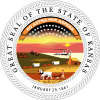Constitutions of Kansas
Under U.S. law, a state requires a constitution. A main order of business for Territorial Kansas was the creation of a constitution, under which Kansas would become a state. Whether it would be a slave state or a free state, allowing or prohibiting slavery, was a national issue, because it would affect voting in the polarized U.S. Senate. Because of tensions over slavery, four quite different constitutions of Kansas were drafted.
Topeka Constitution[]
The Topeka Constitution passed the Topeka Constitutional Convention on December 15, 1855. It met in opposition to the first territorial legislature, from which free-staters were excluded, and that they called "bogus". It was approved territory-wide on January 15, 1856. Free Blacks were excluded from Kansas under this constitution; the "Black exclusion" was voted on separately, but it passed. The constitution was sent to Congress and approved by the House on July 2, 1856, but, opposed by President Pierce, failed in the Senate by two (Southern) votes.
Lecompton Constitution[]
The Territorial Legislature met in Lecompton in September of 1856 to prepare a rival document. The LeCompton Constitution explicitly allowed slavery, the subject of an entire article (Article 7). It was approved in a rigged election in December of 1857, but it was overwhelmingly defeated in a second vote in January 1858 by a majority of voters in the Kansas Territory.
It was sent to Washington anyway. President Buchanan endorsed it, and it was approved by the Southern-dominated Senate, but the House sent it back to Kansas for a vote. It was overwhelmingly defeated a second time on August 2, 1858.[1]
Leavenworth Constitution[]
In the 1856 election the free-staters achieved a majority in the legislature, and they called for another constitutional convention, to head off approval of the Lecompton Constiutution. It met in March 1858 first in Mineola, then in Leavenworth. This constitution, the most liberal of the four, was sent to Congress in January 1859, but Congress took no action.
Wyandotte Constitution[]
The convention met July 5, 1859 in the former community of Wyandotte, today part of Kansas City, Kansas. The Wyandotte Constitution was approved by territorial referendum on October 4, 1859. In April, 1860, the United States House of Representatives voted to admit Kansas under the Wyandotte Constitution. The Senate was still just as opposed to a new free state, and no action was taken until January of 1861, when senators from the seceding slave states abandoned their seats. On the same day the last of them left, January 21, 1861, the Senate passed the Kansas bill.[1] Kansas's admission as a free state became effective January 29, 1861.
The Wyandotte Constitution has remained until the present (2021) Kansas's state constitution.
See also[]
Further reading[]
- Heller, Francis H (1992). Kansas State Constitution : A reference guide. Oxford University Press. ISBN 9780313265105.
References[]
- ^ a b "Constitutions of Kansas", Kansapedia, Kansas Historical Society, 2018, archived from the original on 2019-06-21, retrieved 2020-12-07
- Bleeding Kansas
- Constitutions of Kansas
